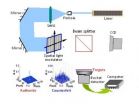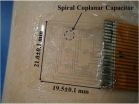(Press-News.org) How do you feed a six-person crew on a three-year mission to Mars?
Food scientists are working on this and other challenges related to creating and optimizing food for astronauts, soldiers, pilots and other individuals working and living in extreme environments, according to a June 23 panel discussion at the 2014 Institute of Food Technologists (IFT) Annual Meeting & Food Expo® in New Orleans.
The constraints often are similar whether the food is created for the desert, mountains, deep sea or space – it needs to be nutritious, palatable, light-weight, easy to store and transport, and stable for months or years depending on the location and duration of the mission.
"Extreme feeding is what we do," said Ann H. Barrett, a food engineer with the U.S. Army Soldier, Research, Development and Engineering Center, Combat Feeding Directive, charged with overseeing food and food packaging for Army staff working in a broad range of conditions and locations. In most instances, the food must remain viable within the designated environment, while giving the soldier, pilot or other staff member the energy and nutrients to survive the physical challenges and harsh conditions of their assignment, said Barrett.
For example, prepackaged meals, called Meal, Ready to Eat (MRE), are 1,300 calories, weigh 1.5 pounds, and are shelf-stable for three years at 80 degrees Fahrenheit.
The National Air and Space Program (NASA) is embarking on "the ultimate challenge," to create a viable food program by 2030 that will feed a six-person team of astronauts for up to three years, said Grace Douglas, PhD, advanced food technology project scientist at NASA.
There will be different gravities on Mars, "we'll have crew in pressurized suits, and ultimately, these astronauts will go much farther from earth for a much longer duration," said Douglas.
"We need to create a safe and nutritious food system that meets space flight requirements," said Douglas. For example, beverages must withstand high pressure, and food must have the appropriate viscosity to remain on a fork or spoon. Optimally, the food will have "crew acceptability," meaning the astronauts want to eat the products over many years.
With current prepackaged foods designed for space, six crew members living on Mars for 1,095 days will require 12,023 kilograms of food. Fortunately, food scientists at NASA and other organizations are working to make prepackaged foods that are lighter, tastier and more nutritious, with a longer shelf life.
For example, Douglas said that NASA scientists recently grew and harvested a head of lettuce on a space flight. The opportunity to someday grow safe, nutritious crops in space could help with nutrition and food variety in space.
INFORMATION: About IFT
This year marks the 75th anniversary of the Institute of Food Technologists. Since its founding in 1939, IFT has been committed to advancing the science of food, both today and tomorrow. Our non-profit scientific society—more than 18,000 members from more than 100 countries—brings together food scientists, technologists and related professionals from academia, government and industry. For more information, please visit ift.org.
From deep sea to deep space
Creating and optimizing food for people living and working in extreme conditions
2014-06-24
ELSE PRESS RELEASES FROM THIS DATE:
Energy drinks raise new questions about caffeine's safety
2014-06-24
Caffeine, which was extensively researched for possible links to birth defects in animals and cardiovascular disease in humans over 30 years ago and then exonerated, has become the focus of renewed concerns as caffeine-containing energy drinks have surged in popularity. However, according to a June 23rd panel discussion at the 2014 Institute of Food Technologists (IFT) Annual Meeting & Food Expo® in New Orleans, a rich database of health evidence exists confirming the safety of caffeine for consumers at current levels of exposure. What isn't known, however, is how caffeine ...
Ghost writing the whip
2014-06-24
WASHINGTON D.C., June 24, 2014 – "Ghost imaging" sounds like the spooky stuff of frivolous fiction, but it's an established technique for reconstructing hi-res images of objects partly obscured by clouds or smoke. Now a group of researchers at the National University of Singapore (NUS) is applying the same idea in reverse to securing stored or shared electronic data.
Described in the journal Applied Physics Letters, from AIP Publishing, the work establishes "marked ghost imaging" technology as a new type of multi-layer verification protocol for data storage or transmission.
By ...
Researchers mapping your route from illness to illness
2014-06-24
This is the first time that researchers have analysed big data relating to an entire country's disease development. The new ground-breaking results are based on data from 6.2 million Danes who were followed for 14.9 years – using state-of-the-art systems biology, researchers have boiled down the massive amount of data to 1,171 so-called thoroughfares with central information on the course of diabetes, chronic obstructive pulmonary disease, cancer, arthritis and cardiovascular disease. The researchers are, in other words, able to forecast whether you are driving on a risky ...
New technology: The goose bump sensor
2014-06-24
WASHINGTON D.C., June 24, 2014 – Can emotional states be measured quantitatively, and if so what would advertising, manufacturing and social media companies do with that data? Imagine a world in which a consumer's real-time physical and emotional response helped to determine his/her experience of music, online ads or the temperature in the room.
That may not be so far away -- a team of researchers at KAIST in Daejeon, South Korea has developed a flexible, wearable 20mm x 20mm polymer sensor that can directly measure the degree and occurrence on the skin of goose bumps ...
Roux-en-Y gastric bypass surgery may reduce heart disease risk
2014-06-24
CHICAGO, IL—Obese patients with Type 2 diabetes who don't have excessive surgical risk may find that Roux-en-Y gastric bypass (RYGB) surgery can help them reduce their risk of heart disease, a new clinical trial shows. The results were presented Tuesday at ICE/ENDO 2014, the joint meeting of the International Society of Endocrinology and the Endocrine Society in Chicago.
"There is emerging evidence highlighting the potential health benefits of bariatric surgery in managing obese patients with Type 2 diabetes. In the past, lifestyle advice and medications provided the ...
Sleep, mood improves after substantial weight loss
2014-06-24
CHICAGO, IL—Obese adults who lose at least 5 percent of their body weight report that they sleep better and longer after six months of weight loss, according to a new study. The results were presented Tuesday at the joint meeting of the International Society of Endocrinology and the Endocrine Society: ICE/ENDO 2014 in Chicago.
"This study confirms several studies reporting that weight loss is associated with increased sleep duration," said the study's lead investigator, Nasreen Alfaris, MD, MPH, a fellow in the Department of Medicine at the Perelman School of Medicine ...
Gastric bypass surgery improves diabetic patients' quality of life
2014-06-24
CHICAGO, IL—An intensive weight loss program involving lifestyle modifications improves obese diabetic patients' physical and mental health as well as gastric bypass surgery does over two years, but the weight loss surgery leads to a greater reduction in adverse effects of obesity on quality of life. These results, from a new study in patients with Type 2 diabetes, were presented Tuesday at the joint meeting of the International Society of Endocrinology and the Endocrine Society: ICE/ENDO 2014 in Chicago.
Gastric bypass also led to patients having a somewhat greater reduction ...
Synthetic triterpenoids show promise in preventing colitis-associated colon cancer
2014-06-24
Researchers from Case Western Reserve and Dartmouth universities have shown that a class of small antioxidant molecules carries enormous promise for supressing colon cancer associated with colitis. These findings, published in an early June edition of the Journal of Clinical Investigation, offer hope that physicians ultimately will be able to reduce dramatically the number of sufferers of this inflammatory bowel disease (IBD) who go on to develop colon cancer.
The molecules, known as synthetic triterpenoids, appear to achieve their positive effect in two ways. First, ...
Helpful bouncing babies show that moving together to music builds bonds
2014-06-24
HAMILTON, ON, June 24, 2014 — Whether they march in unison, row in the same boat or dance to the same song, people who move in time with one another are more likely to bond and work together afterward.
It's a principle established by previous studies, but now researchers at McMaster University have shown that moving in time with others even affects the social behavior of babies who have barely learned to walk.
"Moving in sync with others is an important part of musical activities," says Laura Cirelli, lead author of a paper now posted online and scheduled to appear ...
Food scientists working to diminish, mask bitter tastes in foods
2014-06-24
Food scientists are working to block, mask and/or distract from bitter tastes in foods to make them more palatable to consumers, many of whom are genetically sensitive to bitter tastes, according to a new presentation at the 2014 Institute of Food Technologists (IFT) Annual Meeting & Food Expo® in New Orleans.
"Many factors go into why we eat what we do," said John Hayes, PhD, assistant professor of food science and director of the Sensory Evaluation Center at Pennsylvania State University, with taste consistently ranking as number one. There's also "a huge variability ...
LAST 30 PRESS RELEASES:
School meals could unlock major gains for human and planetary health
Menopause hormone therapy does not appear to impact dementia risk
Signature patterns of brain activity may help predict recovery from traumatic brain injury
Dresden study uncovers new key mechanism in cancer cells
New species are now being discovered faster than ever before, study suggests
Cannabis-based products show limited short-term benefit for chronic pain, with increased risk of adverse effects
Cannabis products with more THC slightly reduce pain but cause more side effects
Clearing the brain of aging cells could aid epilepsy and reduce seizures
Brain injuries linked with potential risk of suicide, new study finds
New technique lights up where drugs go in the body, cell by cell
New study finds movement of fishing fleets can reveal shifts in marine ecosystems
Embargoed: New evidence points to potential treatment for vascular dementia
Study uncovers disrupted brain balance in alcohol dependence
Working in groups can help Republicans and Democrats agree on controversial content moderation online
Structural findings reveal how distinct GPCR ligands create different levels of activation
Anything-goes “anyons” may be at the root of surprising quantum experiments
UC review: Maximizing workplace opportunity for veterans
From generation to complex control: Metasurfaces make perfect vortex beams "within reach"
Thin-film lithium niobate-based detector: recent advances and perspectives
Exploring why some people may tend to persistently make bad choices
How cells balance their protein levels
Nirsevimab vs RSVpreF vaccine for RSV–related hospitalization in newborns
Effectiveness and impact of maternal RSV immunization and nirsevimab on medically attended RSV in US children
AI gives scientists a boost, but at the cost of too many mediocre papers
Next-generation vision model maps tree growth at sub-meter precision
Genes aren’t destiny for inherited blindness, study shows
MIT study: High-fat diets make liver cells more likely to become cancerous
Exposure to multiple fine particulate matter components and incident depression in the US Medicare population
Risk of burdensome health care spending over time in the US
Nirsevimab against hospitalizations and emergency department visits for lower respiratory tract infection in infants
[Press-News.org] From deep sea to deep spaceCreating and optimizing food for people living and working in extreme conditions

